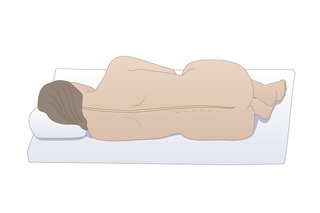A lumbar puncture is where a thin needle is inserted between the bones in your lower spine. It shouldn't be painful, but you may have a headache and some back pain for a few days.
It's carried out in hospital by a doctor or specialist nurse.
When a lumbar puncture may be needed
A lumbar puncture may be used to:
- take a sample of fluid from your spinal cord (cerebrospinal fluid) or measure the fluid's pressure – to help diagnose a condition
- inject medications – such as painkillers, antibiotics or chemotherapy
- inject a spinal anaesthetic (epidural) – to numb the lower part of your body before an operation
- remove some fluid to reduce pressure in the skull or spine
Before having a lumbar puncture
Your doctor or nurse should explain what's going to happen and why you need a lumbar puncture.
A few days or weeks before the test:
- you may have a CT scan or MRI scan – to make sure you need the lumbar puncture and it's safe to have one
- let the hospital know if you're taking blood-thinning medication (anticoagulants) – such as warfarin
On the day:
- you can eat, drink and take medicine as normal
- you'll be asked to sign a consent form
- you'll usually need to undress and change into a hospital gown before the procedure – you might also want to use the toilet
What happens during a lumbar puncture

PETER GARDINER/SCIENCE PHOTO LIBRARY

PETER GARDINER/SCIENCE PHOTO LIBRARY
The doctor or nurse will:
- Clean your skin and numb the area with local anaesthetic (you'll be awake during the procedure). Children may also be given medicine to help them relax and keep still.
- Insert a thin needle through the skin, between 2 bones in the lower part of your spine. This shouldn't be painful, but you may feel some pressure.
- Remove the needle once the procedure is finished and apply a small plaster or dressing.
How long does a lumbar puncture take?
A lumbar puncture takes around 30 to 45 minutes, but you'll need to stay lying down at the hospital for at least another hour while the nurses monitor you.
You'll be able to go home the same day if you feel well enough, but you won't be able to drive yourself home.
Getting the results
The doctor or nurse who performs the lumbar puncture can often tell you some of the results straight away and explain what they mean.
You may need to wait for at least 48 hours for the full results. Some laboratory test results are available within a couple of hours in an emergency.
Side effects of a lumbar puncture
A lumbar puncture is generally a safe procedure and serious side effects are uncommon.
The most common side effects are:
- headaches, which can last for up to a week – you'll be given painkillers at the hospital if you need them
- swelling and lower back pain where the needle was inserted – this should get better on its own after a few days and is normally nothing to worry about
Recovering from a lumbar puncture
While you're recovering from a lumbar puncture:
Do
- drink plenty of fluids
- take painkillers, such as paracetamol
- lie down instead of sitting upright
- try drinks containing caffeine, such as coffee, tea or cola – some people find this helps to relieve the headaches
- remove the dressing or plaster yourself the next day
Don't
- do not drive or operate machinery for at least 24 hours
- do not play sport or do any strenuous activities for at least a week
Non-urgent advice: Contact the hospital team or a GP if:
- your headaches are severe or don't go away
- you're feeling or being sick
- you have a very high temperature or feel hot and shivery
- it's painful to look at bright lights
- the swelling in your back lasts for more than a few days or keeps getting worse
- you see blood or clear fluid leaking from your back
What we mean by severe pain
Page last reviewed: 23 January 2018
Next review due: 23 January 2021
